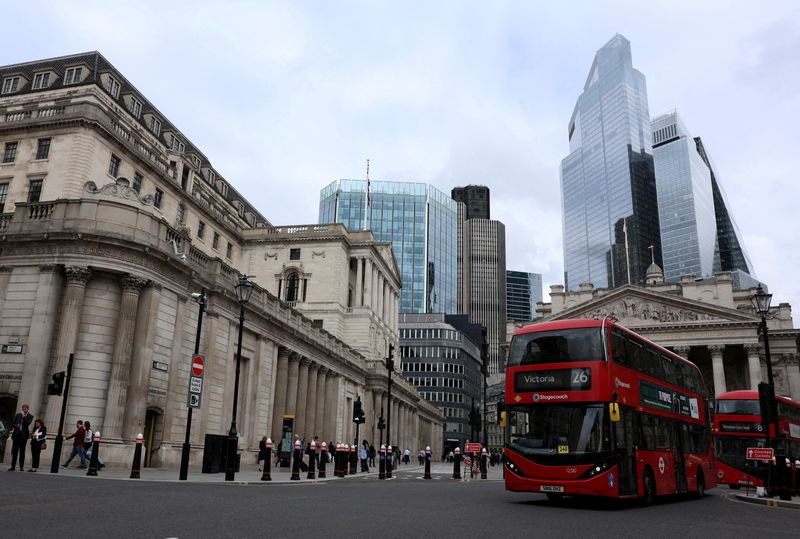By David Milliken
LONDON (Reuters) – The Bank of England looks set to hold interest rates at 4.75% on Thursday, despite signs of a slowing economy, as persistent inflation pressures limit it to a “gradual” approach towards cutting borrowing costs.
All 71 economists polled by Reuters said rates would stay unchanged for now. Most expect a quarter-point cut only on Feb. 6 after its next meeting, followed by three more cuts by the end of 2025.
Financial markets are much less certain about the extent of rate cuts next year, following data on Tuesday that showed an unexpected acceleration of wage growth. Investors late on Wednesday priced in just a 50% chance of a rate cut in February and only two cuts in 2025 as a whole.
By contrast, the European Central Bank has cut rates by 1 percentage point in 2024 and is expected by markets to lower them by another percentage point in 2025 as the euro zone economy is hit by political turmoil and the risk of a U.S. trade war.
The divergence in interest rate outlooks has pushed the difference in yields between British and to its widest since 1990.
While the U.S. Federal Reserve only expects to lower rates twice next year, its rate cut on Wednesday added up to a cumulative 1 percentage point of loosening in 2024, double the speed of the BoE so far.
Governor Andrew Bailey this month reaffirmed the BoE’s message that “a gradual approach to removing policy restraint remains appropriate”.
The BoE’s November forecasts – which showed inflation staying just above its 2% target until 2027 – were based on market expectations of four rate cuts next year.
BoE officials have not been explicit about whether they view this pace of cuts as the most likely scenario.
Economists expect the BoE to stick to its vaguer message of gradualism in December’s policy statement.
“We think it’s too early for the BoE to pre-commit to a sustained cutting cycle or to conclude that risks to inflation returning sustainably to the 2% target in the medium term have dissipated,” Bank of America analysts said in a note to clients.
Most economists polled by Reuters expect an 8-1 Monetary Policy Committee vote to keep rates unchanged. Swati Dhingra, who has called for faster cuts, is seen as the likeliest dissenter.
INFLATION AND WAGE GROWTH TOO HIGH
British consumer price inflation – which peaked at a 41-year high of 11.1% in October 2022 – fell below the BoE’s 2% target for the first time in three and an half years in September, but rose to 2.6% in November.
That exceeded the BoE’s own forecast of 2.4% and was the highest rate among the Group of Seven advanced economies. Services price inflation, which the BoE views as a better guide to medium-term price pressures, held at 5.0%.
The bigger concern is wage growth, which hit an annual 5.2% in the three months to October – well above the 3% rate most MPC members view as consistent with 2% inflation.
The BoE is watching to see if finance minister Rachel Reeves’ decision to load an extra 25 billion pounds ($32 billion) of employment taxes on businesses leads to more price rises or to cuts to jobs and pay.
Business sentiment has tumbled since Reeves’ Oct. 30 budget, and economic output fell for two consecutive months for the first time since 2020.
However, most economists say it is too early to know if this slowdown will put much downward pressure on inflation.

“We don’t think there is enough in the data to shift the MPC from its cautious, gradual tone,” RBC economist Cathal Kennedy said, adding that new BoE forecasts at its February meeting would be key.
($1 = 0.7882 pounds)
#Bank #England #rates #steady #price #pressures #linger #Reuters